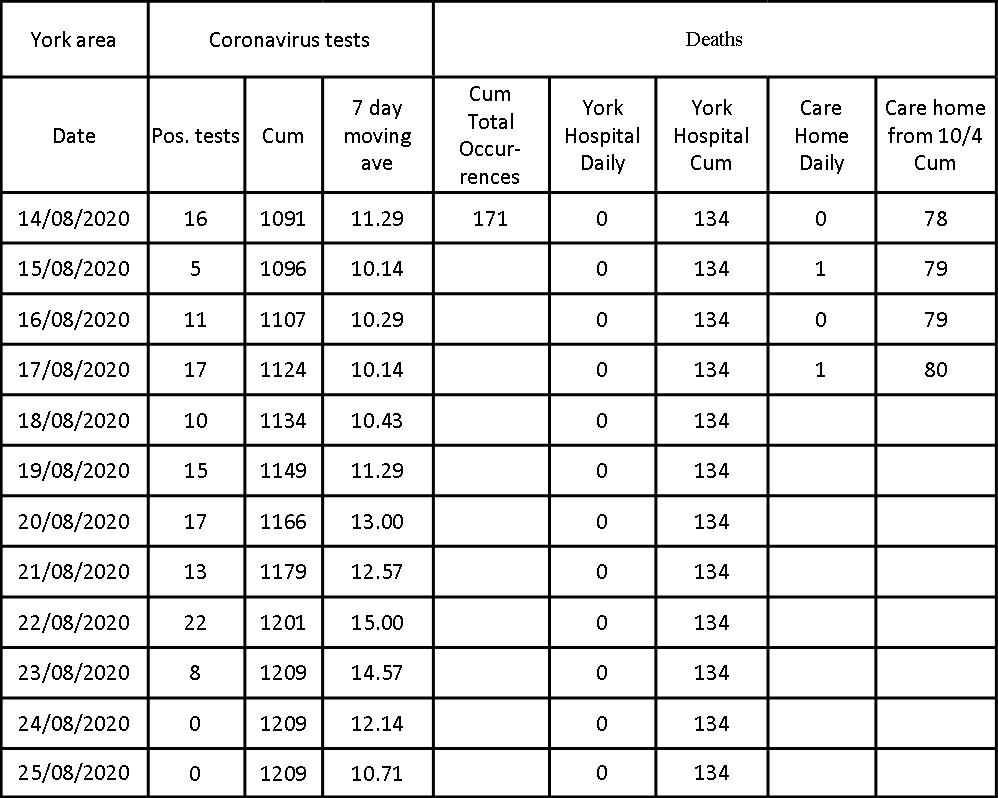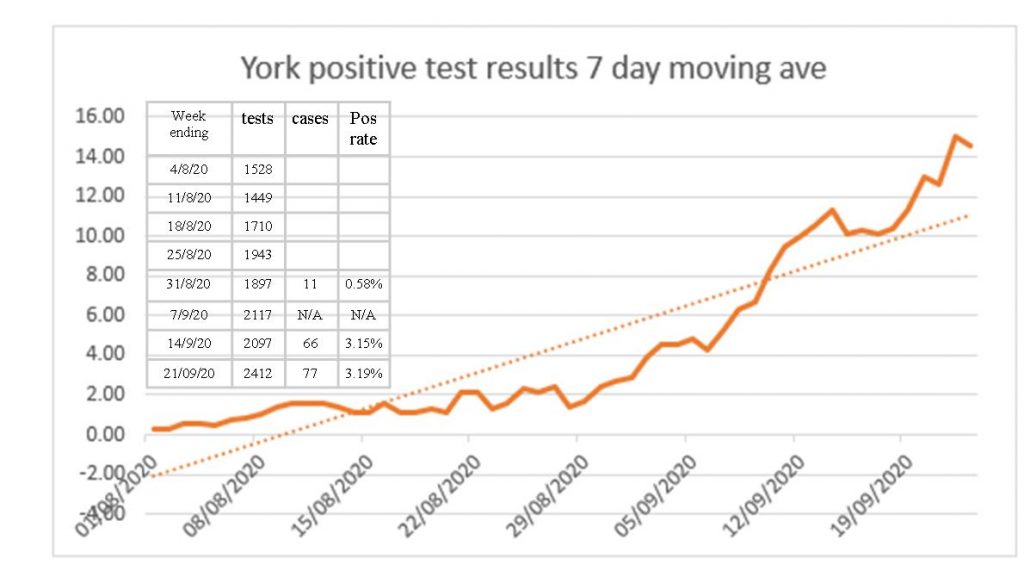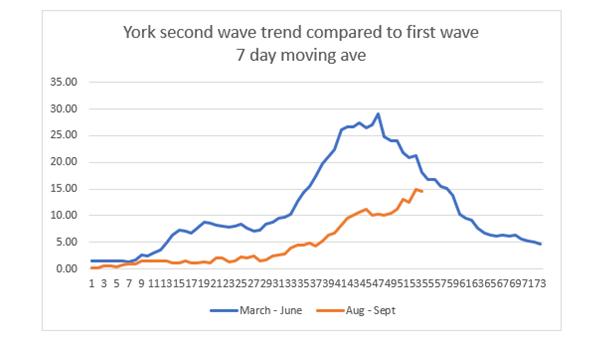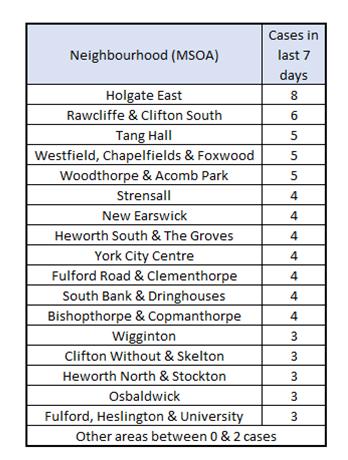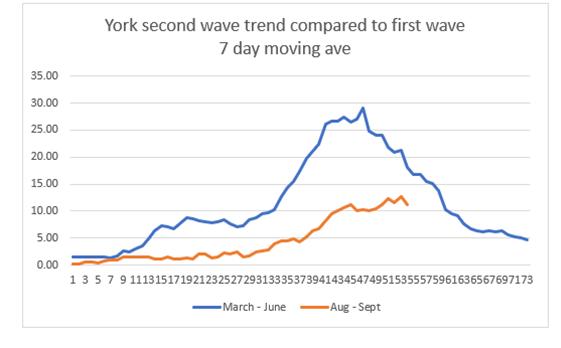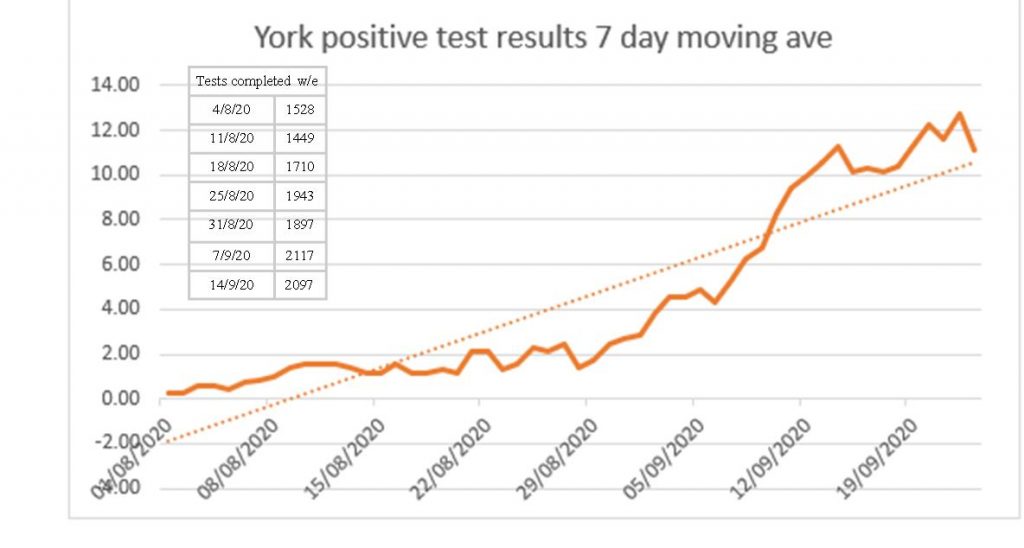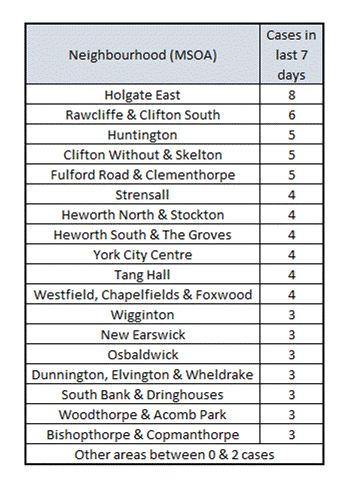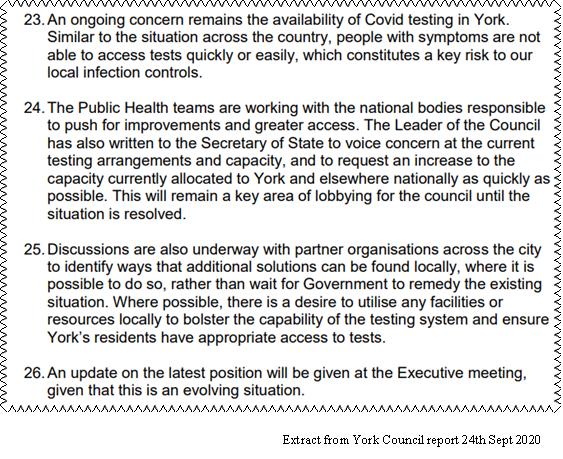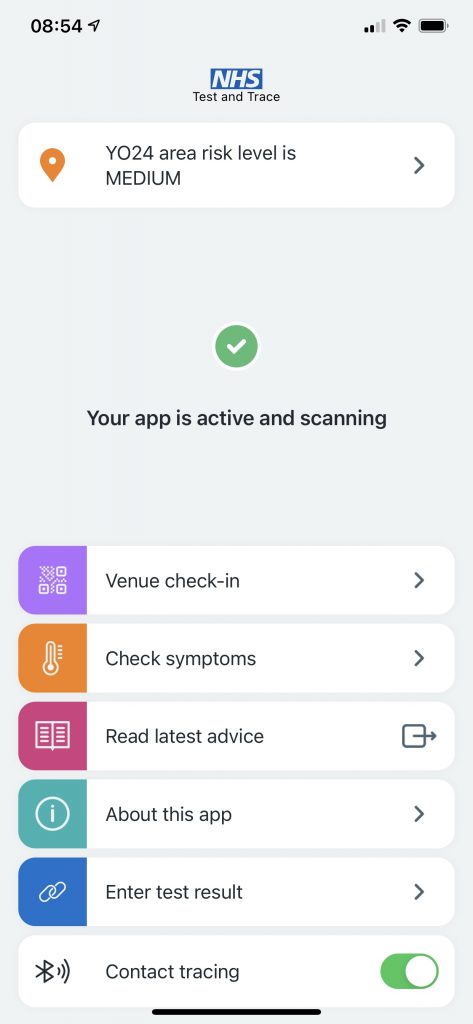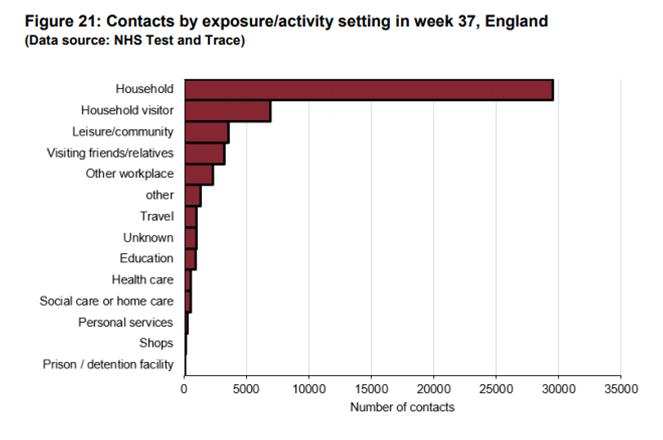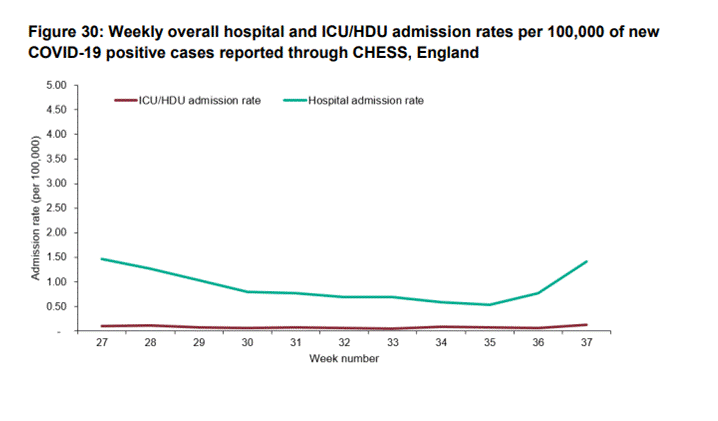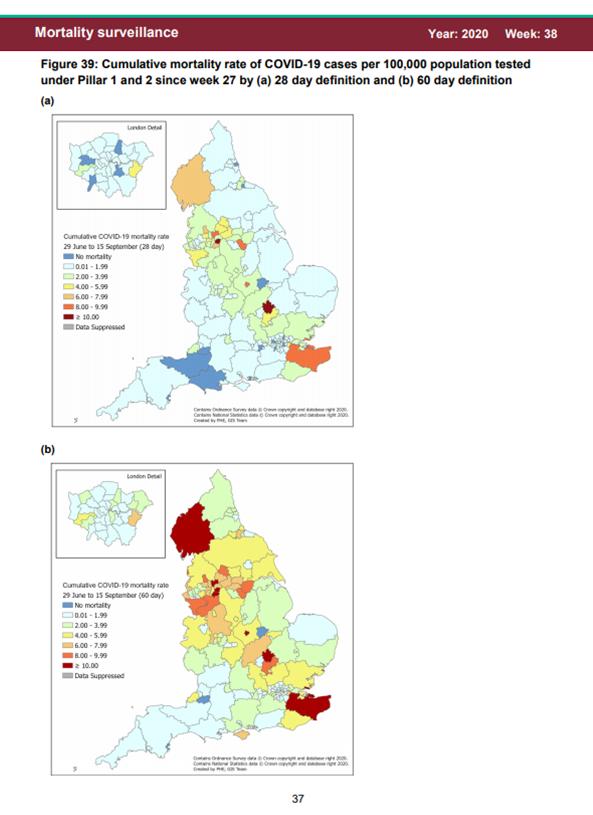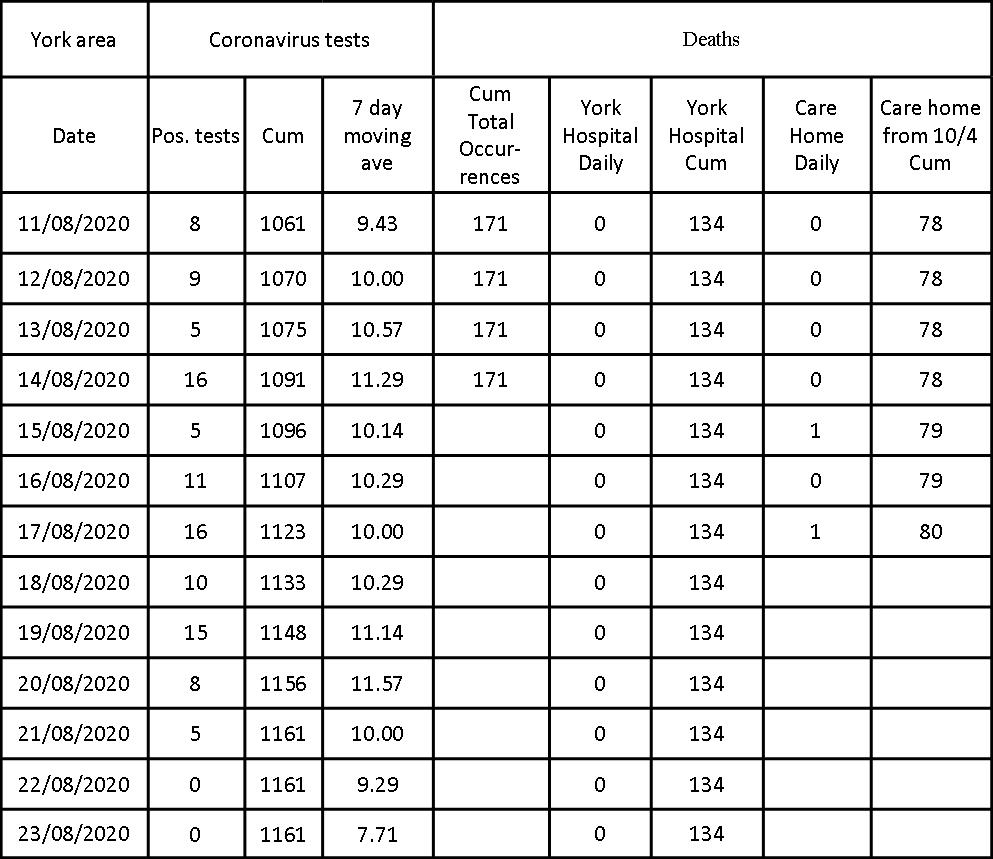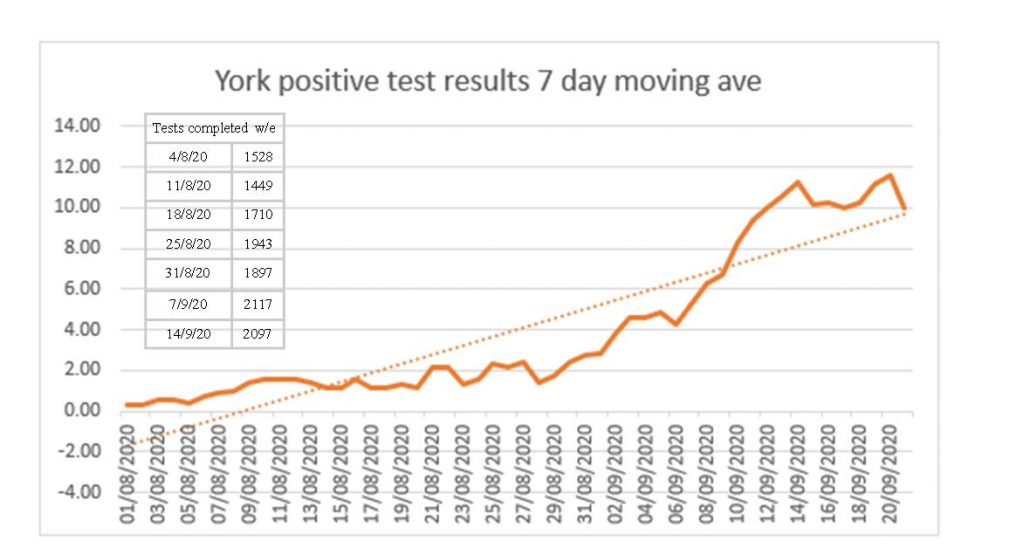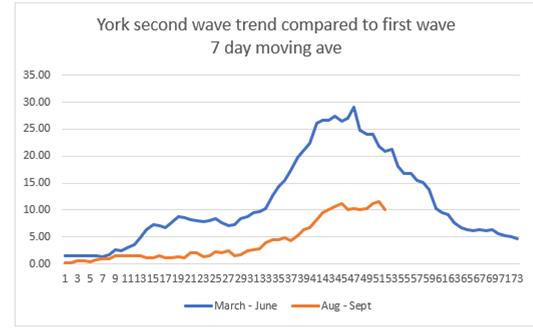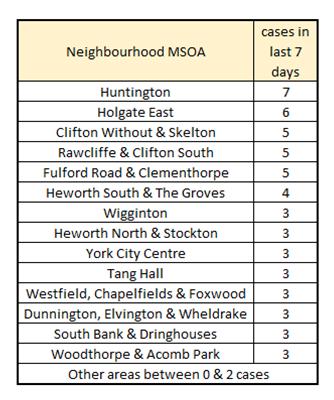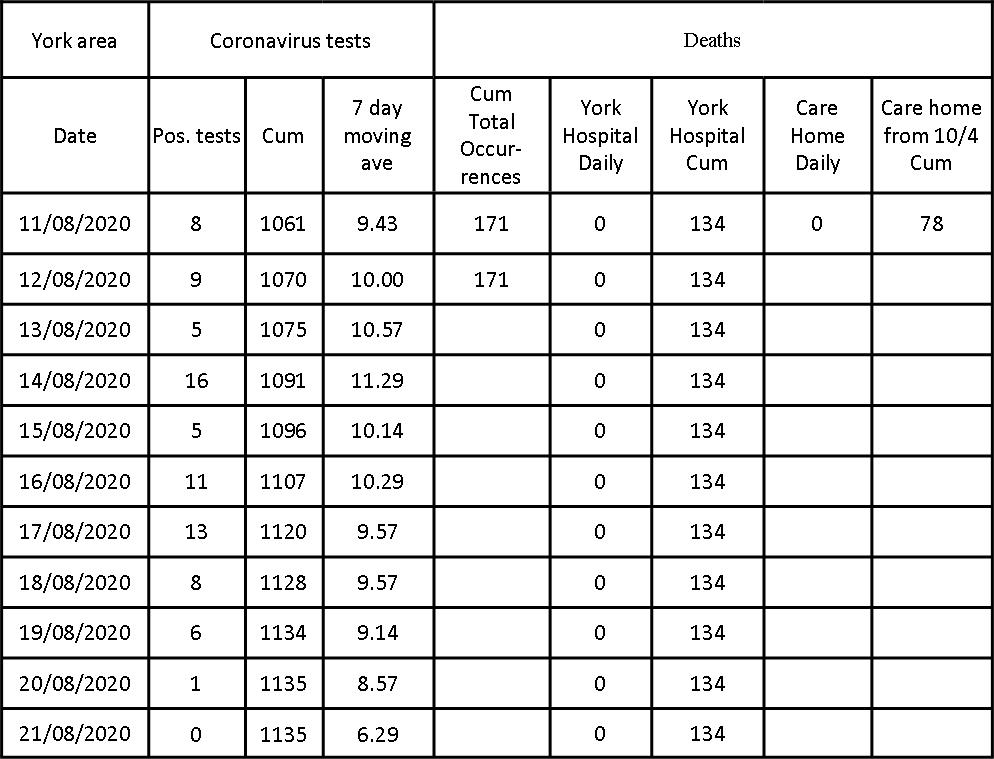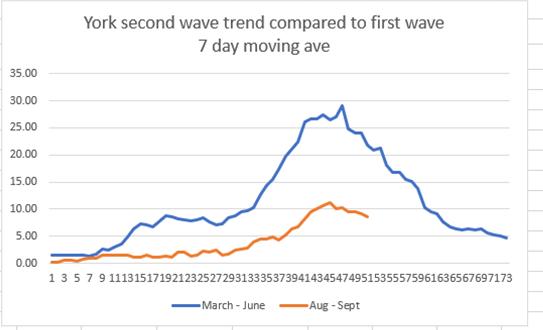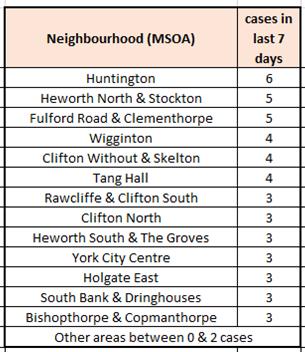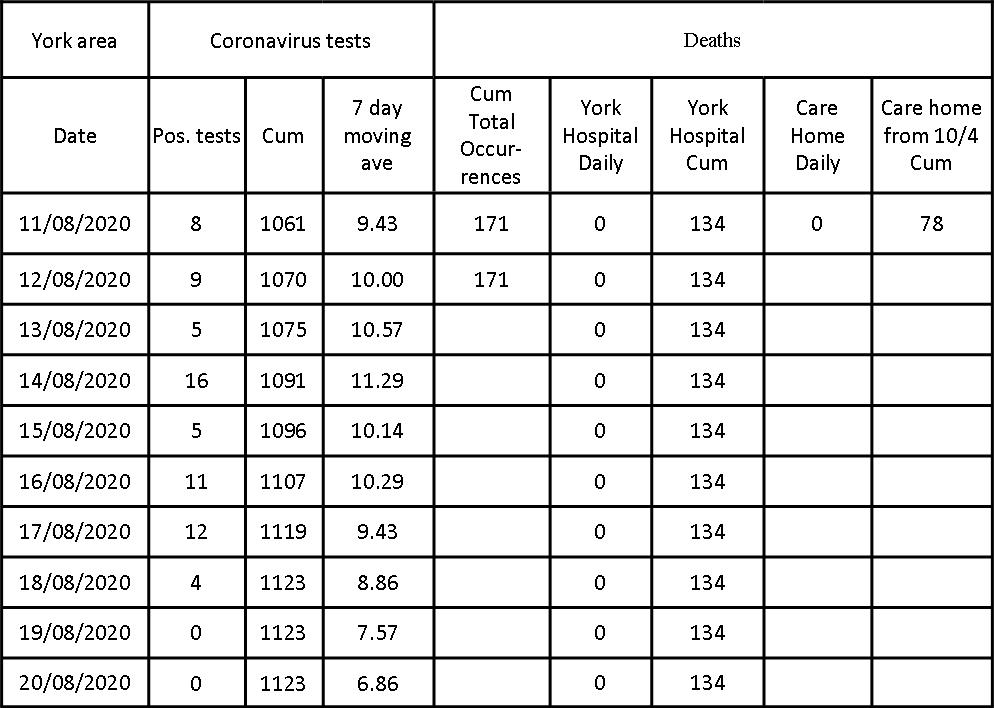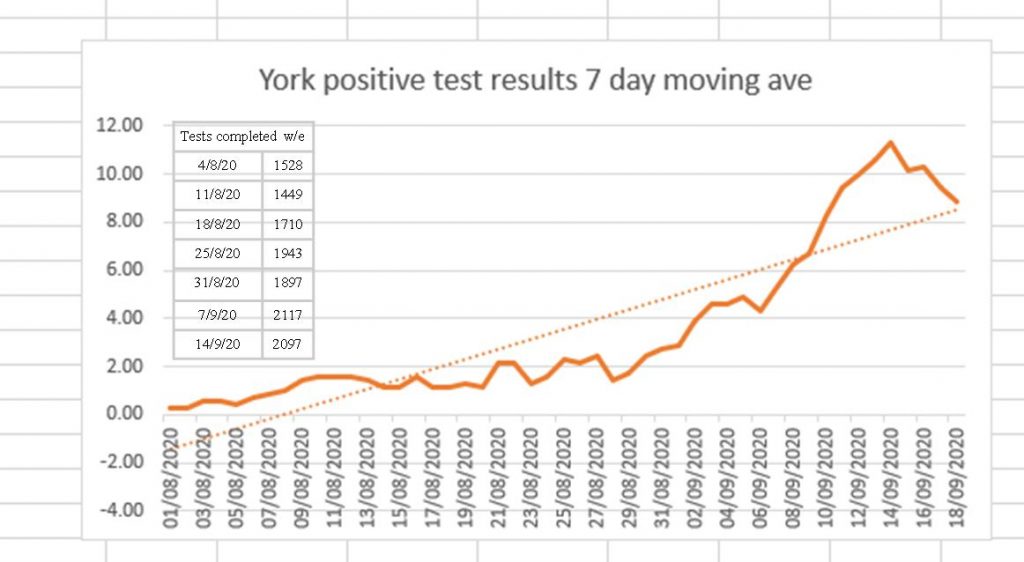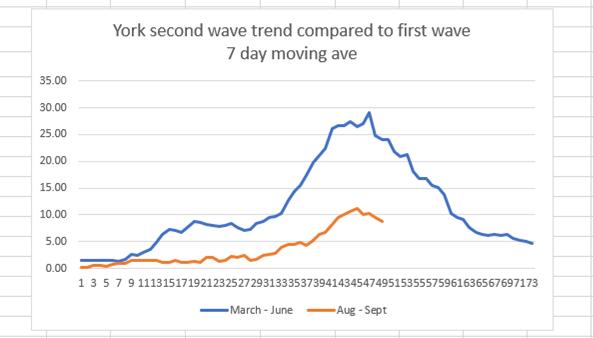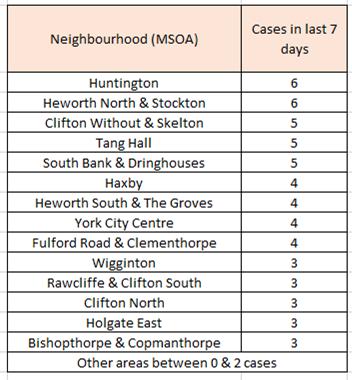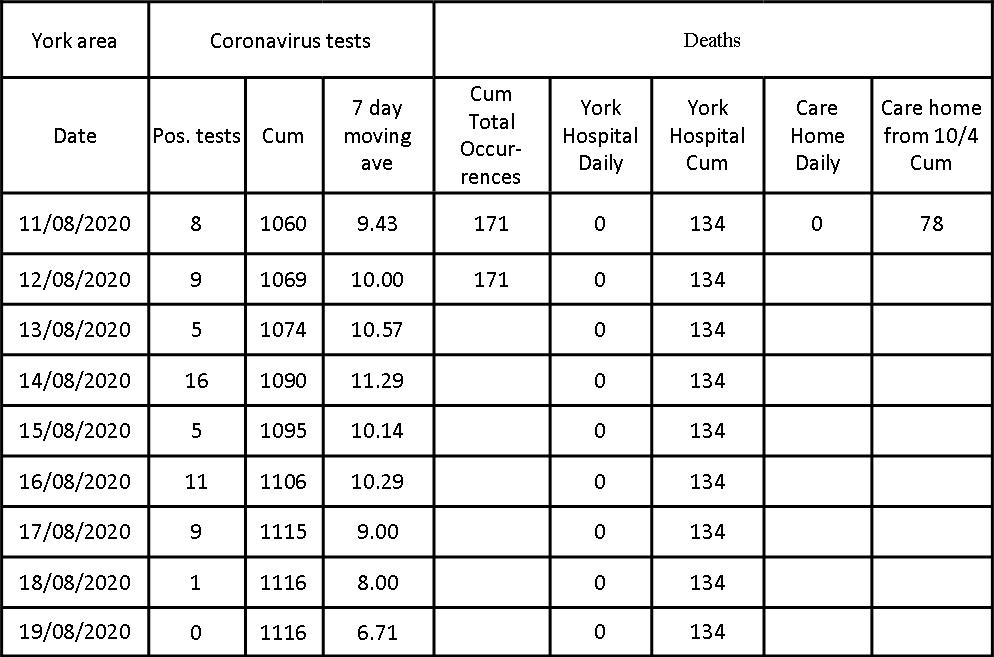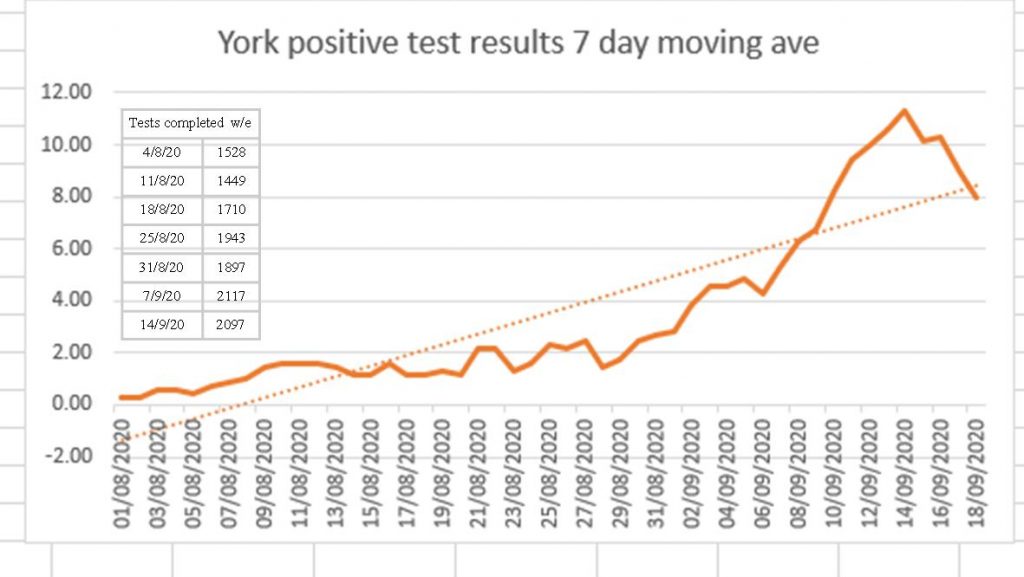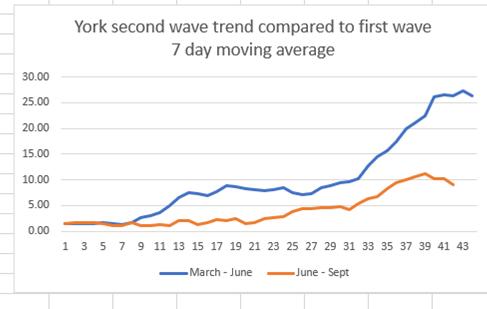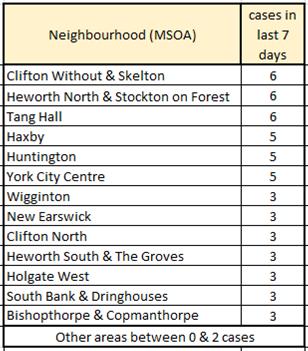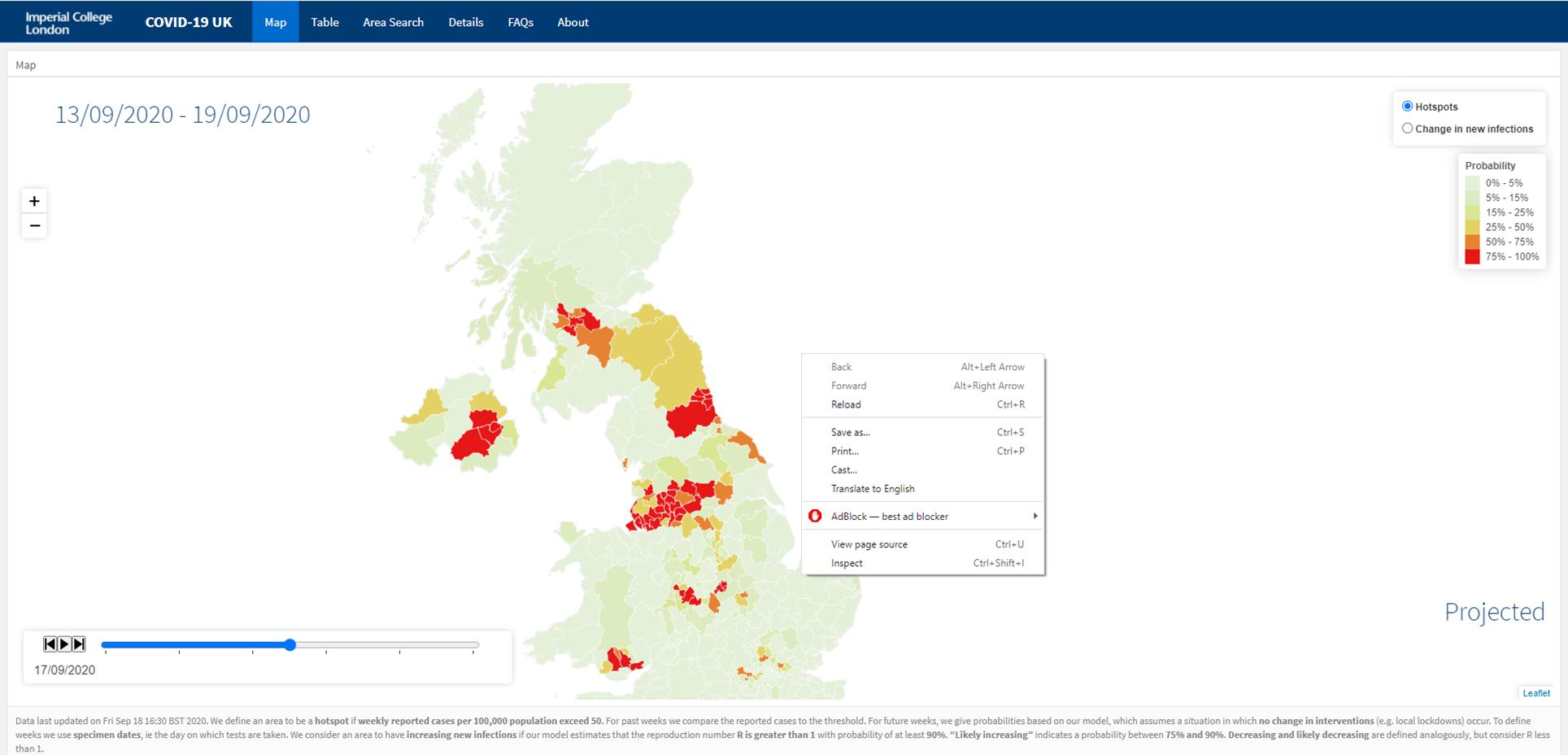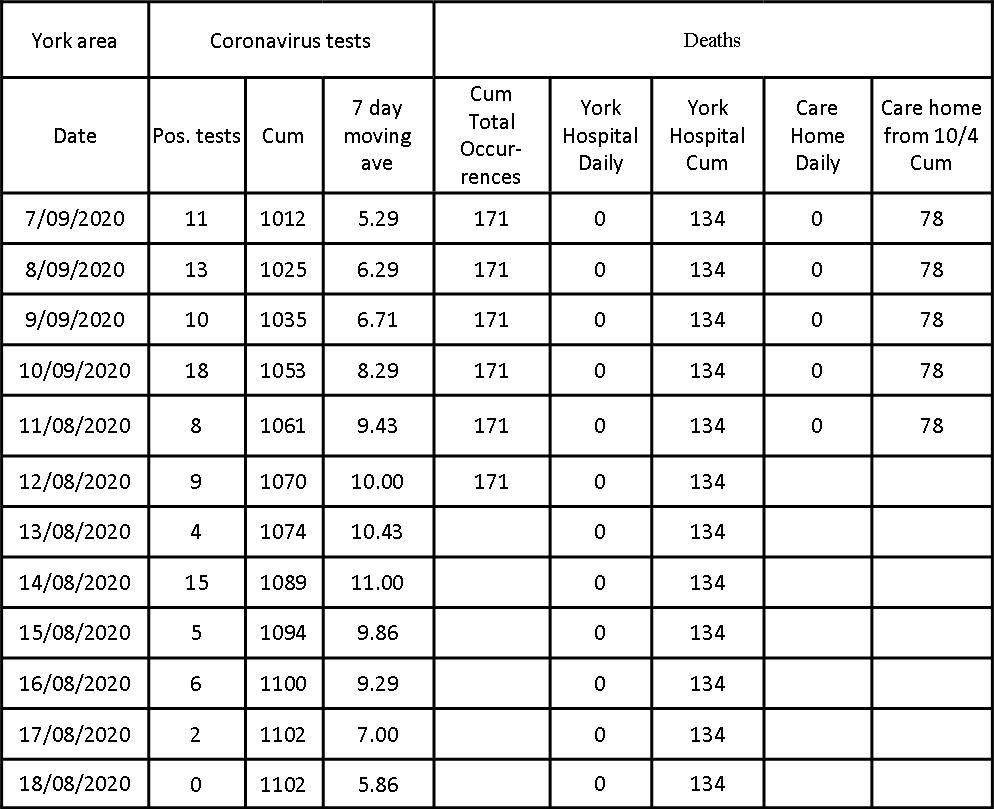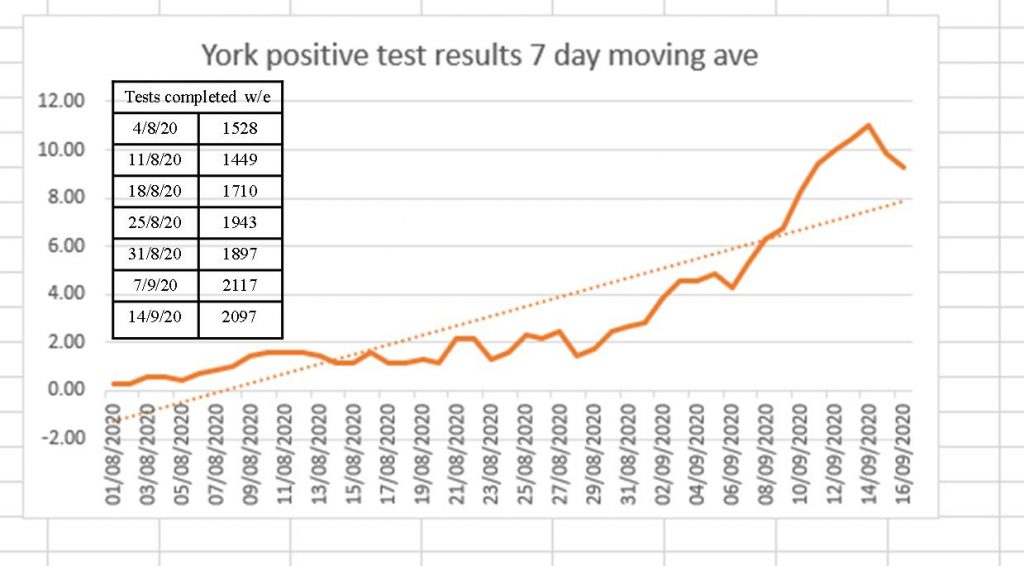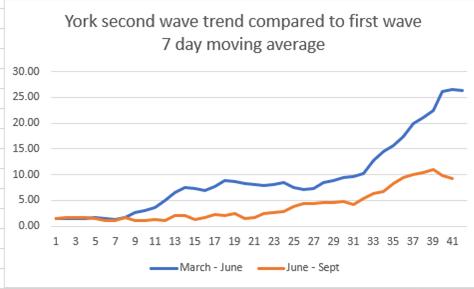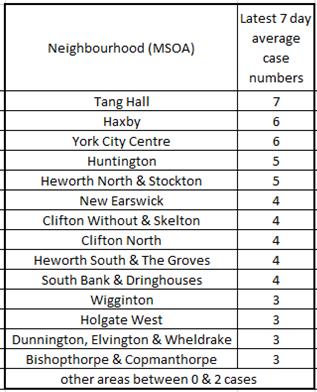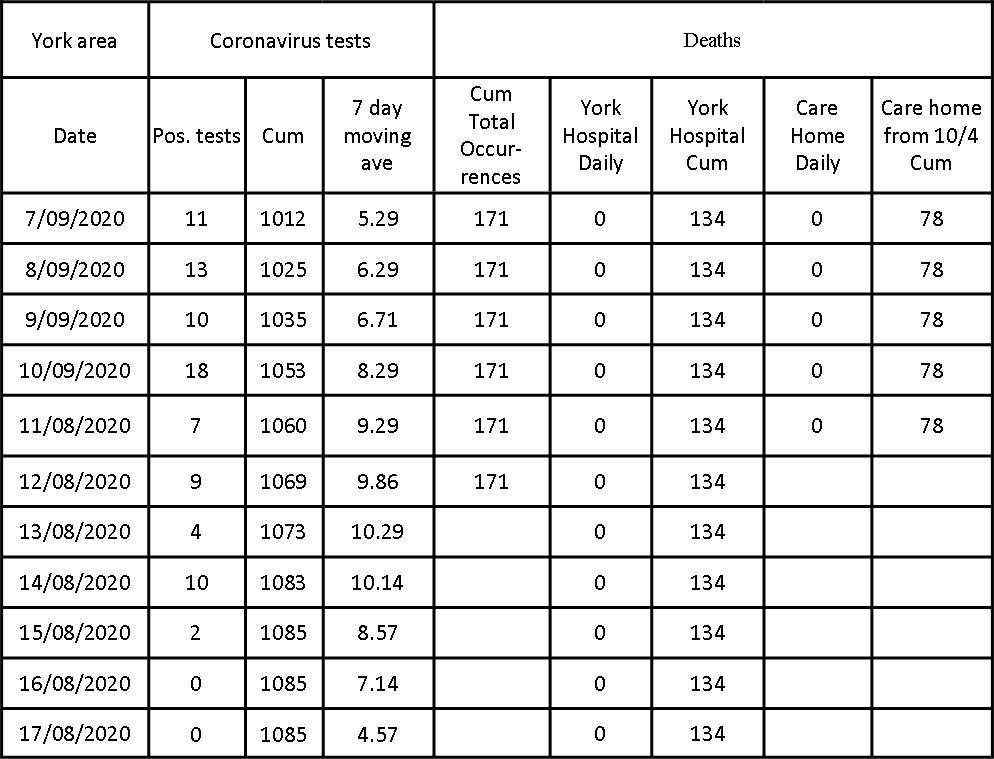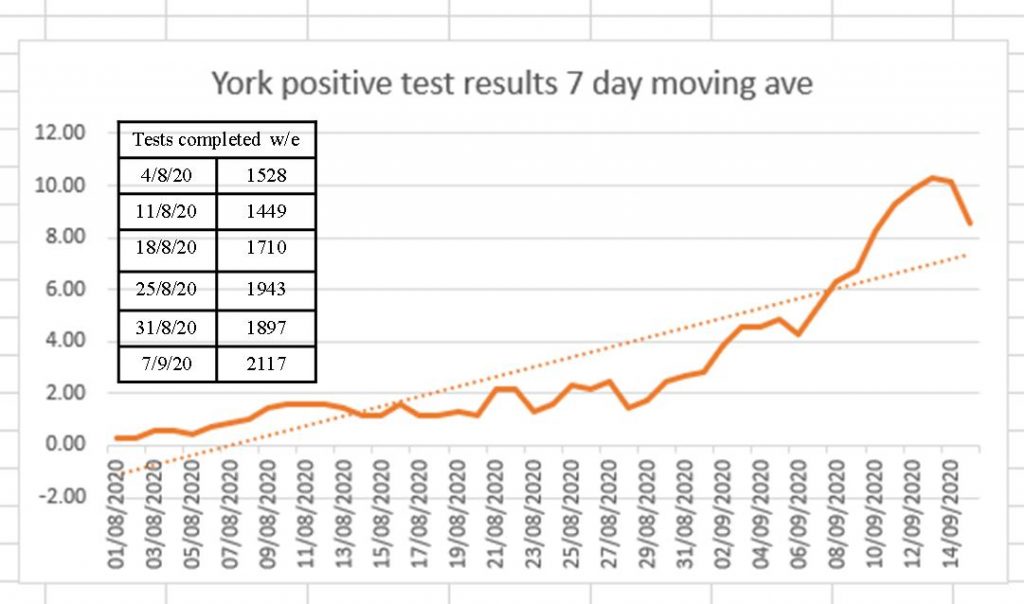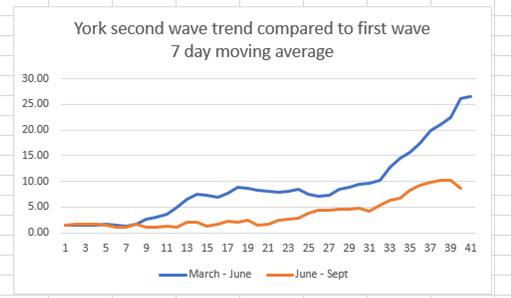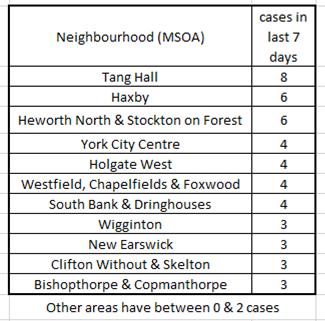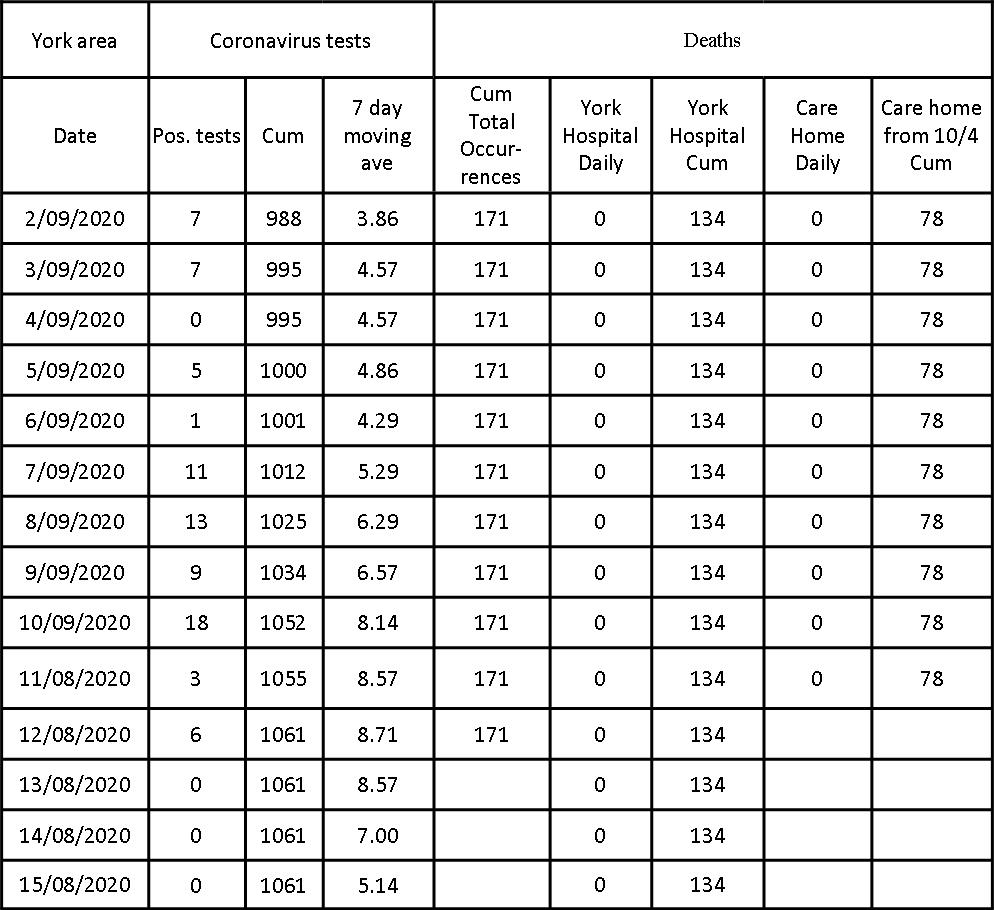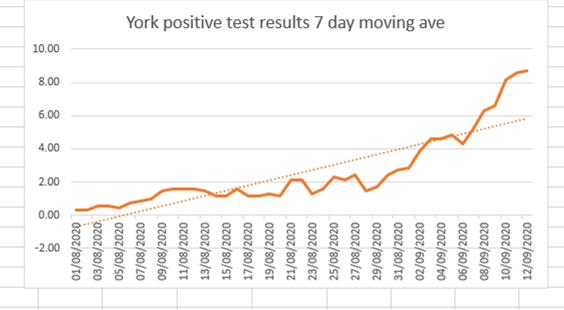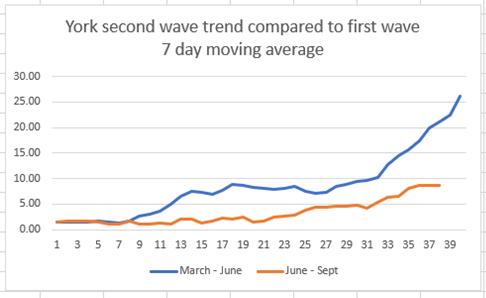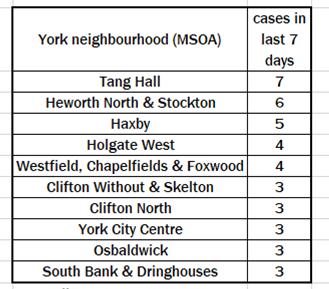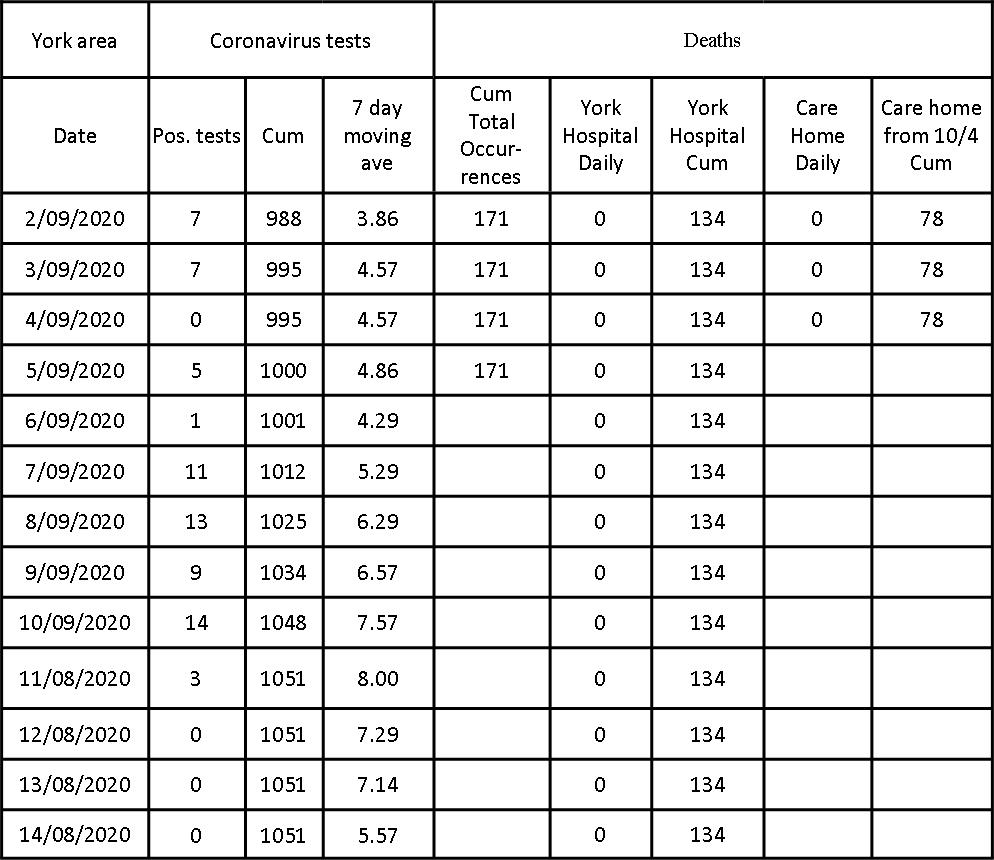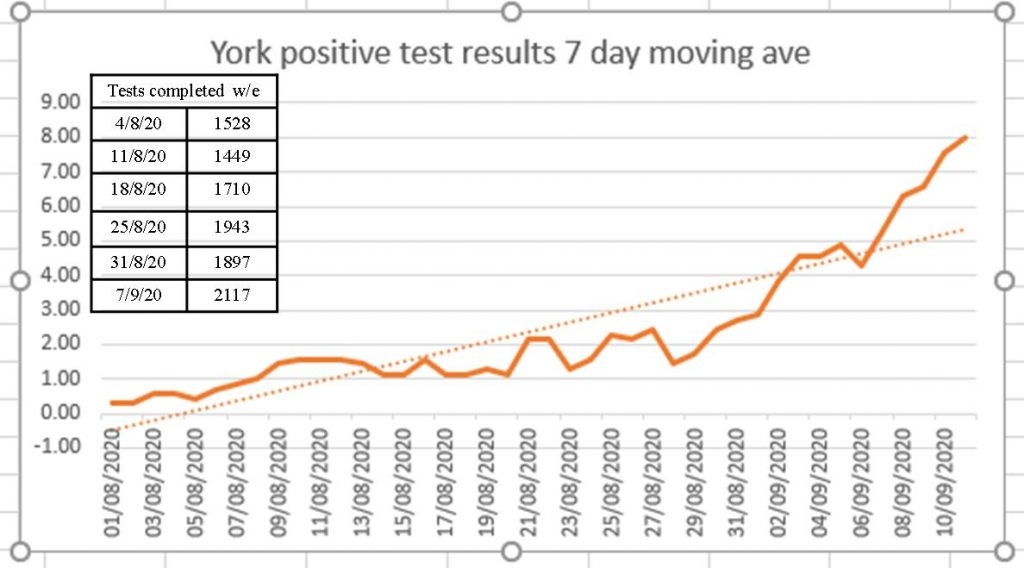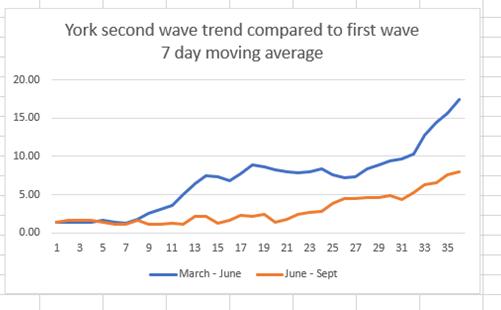Deaths and test results
An additional SEVENTEEN positive test results were announced today bringing the total number of cases to 1102.
Around 11 new cases are being found each day. That compares to the highest, 7 day moving average, number of new cases in the first wave in May which was 29.
The worst affected neighbourhoods are currently Tang Hall, Haxby and the City Centre. A map showing the distribution of cases can be found by clicking here
There have been no more hospital deaths. The last Coronavirus related death in the City occurred in July.
Latest commentary from York Council on pandemic trends
Diagnosed cases (Pillar 1&2 combined)
• As at 17.9.20 York has had 1,085 cases, a rate of 515.2 per 100,000 of population. The rate in York is lower than national (584.9) and regional (757) averages.
• The PHE ‘Exceedance’ rating compares the no. of new cases over a 14 day period with the previous 6 weeks and provides a RAG rating to indicate if the previously observed trend in the no. of new cases is worsening. The latest rating for York (14.9.20) is Red. The rating was triggered by a higher than ‘expected’ number of cases per 100 tests five times in the last 14 days. We know that in recent weeks the number of cases have been low in York which has an effect on the thresholds used to determine the RAG rating – a small change can mean the difference between a red, amber and green rating. The exceedance rating should not be considered in isolation but in context alongside other factors such as the recent total number of cases, COVID related deaths, outbreaks as well as changes in the local testing regime and local hotspot analysis.
• The latest weekly National Covid-19 Surveillance Report released on 11.9.20 and covering the week up to 6.9.20, showed that the 7 day rate of new COVID-19 cases per 100,000 population tested under Pillar 1 and 2 was 12.86 for York. York was ranked 47th out of 149 local authorities (with 1 being the lowest rate).
• The latest validated 7 day rate of new COVID-19 cases per 100,000 population for York is 30. This is for the 7 day period up to 11.9.20. This excludes cases with a sample date in the last few days due to partial data and lags in reporting. The rate in York is increasing but remains lower than national (34.1) and regional (49.1) averages.
• As at 14.9.20, the latest 7 day positivity rate in York (Pillar 2 only) was 3.15% (66 positives out of 2,097 tests). The national and regional averages are 2.1% and 3.2% respectively.
• As at 15.9.20 the latest 14 day positivity rates in York were 0.4% for Pillar 1; 4.5% for Pillar 2 and 3.1% overall. The national averages were 1.2%, 3.9% and 3.1% respectively.
Deaths
The two sources about deaths from Covid-19 at LA level are ONS data and local registrar data. They are derived from the same source (civil registration data). ONS data is more comprehensive as it includes deaths of York residents which have occurred and been registered outside York. Local registrar data is useful as it provides a breakdown by age and gender. The most recently available data is summarised below:
• ONS weekly data: For deaths occurring up to 4th September 2020 and registered up to 12th September 2020, 171 deaths were recorded as having occurred for CYC residents (83 in hospital, 76 in care homes, 9 at home and 3 in a hospice. The number of deaths per 100,000 of population in York is 81.19 which is lower than the national average of 88.43. The most recent death reported for a York resident was in week 31 (25 to 31 July).
• ‘Excess’ deaths (ONS). In week 36 (29 August to 4 Sept), 40 deaths occurred in York, which is 9 more than the average weekly number for 2014-18. Over the last 15 weeks the total number of deaths in York has been 36 fewer than the average for the equivalent weeks in 2014-18.
• Local Registrar data: In the weekly data received on 14.9.20 (for deaths occurring up to 9.9.20), a cumulative total of 162 deaths of CYC residents where COVID-19 was mentioned (confirmed or suspected) on the death certificate, have been registered. The average age of the people who died was 82.47, with an age range of 53-104. The age profile of those dying in York is slightly older than the national average. 86 of the 162 were male (53.1%), slightly less than the national average (55%). 81 of the deaths occurred in hospital and 81 were community deaths (e.g. at home or in a care home or hospice). 70 people (43.2%) died in nursing /care homes (the national average is 29.53%). In addition 13 people (8%) who normally resided in nursing/care homes in the CYC area, died in hospital.
Data on deaths occurring in hospital are shown below. Deaths are initially reported for York NHS Foundation Trust which includes Scarborough Hospital and the further breakdown by site can be delayed. From local registrar data, 58.5% of COVID-19 deaths occurring at York Hospital have been CYC residents. (NB NHS Trusts record deaths following a positive covid-19 test whereas ONS record deaths where covid-19 in mentioned on the death certificate so the totals are not the same).
• Deaths at York Hospital: As at 17.9.20, 134 deaths of people who had tested positive for COVID-19 and were being cared for at York Hospital have been reported. 214 deaths have been reported by the wider York NHS Trust
Disabled and less mobile residents invited to online workshop about city centre accessibility
City of York Council is inviting disabled and less mobile people across York to an online workshop on 23 September.
The council want residents to let them know how city centre changes made in response to coronavirus have affected accessibility.
Emergency measures were agreed by the council executive back in June 2020 to expand a number of city centre ‘footstreets’ to allow more space for social distancing and give business the opportunity to take advantage of pavement trading.
These steps were taken to support the council’s Economic Recovery – Transport and Place One Year Strategy, agreed upon by the Executive on 24 June 2020. The strategy aims to reassure and demonstrate to residents, visitors and stakeholders that York is a safe, healthy and attractive place for everyone.
As a result of these changes, blue badge parking was relocated to a variety of locations around the edges of the city centre. In addition, a free taxi service has been available between Monk Bar car park and St Andrewgate to improve access to the city.
In light of these fast-paced changes, the council want to hear from all disabled and less mobile people in York, whether they use a blue badge or not, and any other residents who feel the footstreets extension has affected their ability to access the city centre.
You can join the conversation in a number of ways:
The council is trying to contact every disabled group in the city. If you are part of a group or network that would like to discuss the changes, please contact us on OurBigConversation@york.gov.uk
Rules – Testing and mitigating the transmission of Covid-19
You may be aware that the national Covid-19 testing programme is under pressure, with high demand impacting capacity.
It is important to get tested if you develop the main symptoms of Covid-19, which are a high temperature, a new and repetitive dry cough, or a change in sense of taste or smell. These are currently the main symptoms that would trigger the need for a test.
If you are otherwise unwell with different symptoms, you do not currently need to get a Covid-19 test. Getting a test when you do not have Covid-19 related symptoms will reduce the capacity of the system to test those who do have symptoms.
To access a test, you can either use the online testing booking portal: https://www.gov.uk/get-coronavirus-test, or by calling 119.
Testing is one element of an infection prevention and control process. Whilst testing can be provide a reassurance and enable the contact tracing process to begin where this might be delayed, there are many other steps that can still be taken which are effective: https://www.gov.uk/government/publications/wuhan-novel-coronavirus-infection-prevention-and-control/updates-to-the-infection-prevention-and-control-guidance-for-covid-19
The most effective action we can all take if we experience symptoms is to self-isolate and request a test. There may currently be delays or reduced access to testing appointments, if you experience difficulties accessing a test, please keep trying.
Self-isolating as a household when one household member has symptoms is necessary. Please familiarise yourself with the online guidance on self-isolation: https://www.gov.uk/government/publications/covid-19-stay-at-home-guidance, and on what the definition of a close contact is, available here: https://www.gov.uk/government/publications/guidance-for-contacts-of-people-with-possible-or-confirmed-coronavirus-covid-19-infection-who-do-not-live-with-the-person/guidance-for-contacts-of-people-with-possible-or-confirmed-coronavirus-covid-19-infection-who-do-not-live-with-the-person
If you have any of the Covid-19 symptoms, you must self-isolate straight away for 10 days – or longer if you still have symptoms. If you live in the same household as someone with coronavirus symptoms, you must self-isolate straight away for 14 days. This is because of the incubation period for the virus and the amount of time in which you are at risk of infecting others if you do have the virus.
York Council reacts to increase in cases – Let’s keep safe
As numbers of confirmed Coronavirus cases increase locally and nationally, City of York Council is encouraging residents and businesses to continue their work in keeping each other safe.
Since the pandemic began, businesses and residents have gone to great efforts to protect each other. Data from Google mobility showed that York residents stayed home more than anywhere else in the region during lockdown, whilst businesses across the city have adapted to delivering their services differently to keep people safe.
However, in line with the national trend, cases are increasing in the city. Therefore, it is vital that people stay vigilant and practice good public health measures and remember: Hands. Face. Space.
Following an increase in cases across the country, Monday saw the introduction of the rule of six, meaning you must not meet in a group of more than 6, indoors or outdoors. Meeting in groups of more than six is now against the law and the police have the powers to enforce these legal limits, including to issue fines (fixed penalty notices) of £100, doubling for further breaches up to a maximum of £3,200.
The rule of six means you can only meet with people outside of your household group in a group of no more than 6 people. This applies whether you are meeting in your home, outside in the park or at a venue like a restaurant.
Please remember that the principles remain, to stop the spread of the virus we all need to all remember:
- Hands – Wash your hands regularly and for 20 seconds or more each time
- Face – Wear a face covering in public spaces it isn’t easy to social distance in (plus be considerate of those who are exempt and share pictures of you wearing them on social media as part of the #WeveGotItCovered campaign!)
- Space – Keep our distance – 2m is best
- Test – Stay at home if you have symptoms and ask for a test.
The council is aware that due to testing capacity challenges nationally, some people here are struggling to access a test. For now, people with symptoms (a dry continuous cough, a high temperature or a loss of or change in sense of taste and smell) are asked to self-isolate at home until they are able to get a test. The Council continues to press the Government for more testing capacity locally, following letters to the Secretary of State.
Last night saw the North Yorkshire Local Resilience Forum outline work putting in place additional measures and declaring a major incident to slow the spread in some parts of the County following increasing cases in North Yorkshire. In York, we are asking residents and businesses to be vigilant and remember hands, face, space to keep you and your communities safe.
